Posts Tagged ‘Quality Control Services In China’
Must-Know Common Product Assembly Defects for Your Business Success

When importing goods, product assembly defects can pose a significant challenge for businesses. The consequences of discovering that your products are defective or hazardous after selling them to customers can be dire. In this article, we’ll dive into some of the most common assembly defects that can arise during a product manufacturing process and provide you with tips to steer clear of them.
Poorly Designed Molds
During the manufacturing process, molds are employed to give shape to the product. If the molds are poorly designed, they may produce misshapen or flawed products.
Precision molds, in particular, are critical for plastic products like toys. A mold that’s inadequately designed can also result in malfunctioning products that could pose a risk to the consumer.
To prevent this problem, it’s imperative to collaborate with a reputable manufacturer that has experience designing and manufacturing top-notch molds. A good manufacturer would typically have a team of engineers and designers who can develop molds that meet your requirements and are of exceptional quality.
They should also possess the appropriate equipment to create the molds and undertake quality control checks to verify that they meet the necessary standards.
Misaligned Parts
When the components of a product are not properly aligned during assembly, misaligned parts can occur, which can lead to unstable products that may break apart and cause safety hazards for users.
For instance, a child’s toy that is not assembled well can pose a significant risk of injury. To prevent misaligned parts, it is crucial to implement rigorous quality control measures, such as conducting visual inspections and testing finished products.
Additionally, manufacturers should have a dedicated quality control team that carries out checks throughout the manufacturing process to ensure that all components are assembled correctly.
By doing so, the likelihood of misaligned parts can be minimized, ensuring that the final product is both safe and reliable.
Poor Quality Control
Assembly defects can often be traced back to poor quality control, making it critical to have robust quality control processes in place. By adhering to these processes, manufacturers can ensure that their products meet safety standards and are of the highest quality.
To minimize the risk of defects, it’s crucial to choose a manufacturer with a strong quality control system in place. Such a manufacturer should have a dedicated team responsible for checking all products before shipping and conducting regular audits to identify opportunities for improvement in their production processes.
This approach will help ensure that the products are consistent, reliable, and meet consumer expectations.
Inconsistent Materials
When it comes to product assembly, using inconsistent materials can lead to defects. The variation in material quality can make it challenging to achieve consistency in the end product. The outcome may be products that are unsightly or malfunctioning.
To prevent this issue, it’s crucial to ensure that your manufacturer sources materials of high quality and implements a reliable system to detect inconsistencies in the materials.
This may involve conducting tests on materials before they are used in production and maintaining consistent material suppliers.
Furthermore, manufacturers must carry out routine quality control checks on materials to ensure that they meet the required standards.
Improperly Installed Components
Inadequately installed components may give rise to assembly defects, which occur when a component is improperly installed during the manufacturing process. This may lead to products that are either unfit for their intended purpose or unsafe for consumers.
To steer clear of such problems, it is essential to implement a rigorous quality control process to verify that all components are installed correctly. This process can include thorough visual inspections and testing of finished products.
Moreover, manufacturers should establish a quality control team that is accountable for scrutinizing all components before they are assembled into finished products. By doing so, they can prevent potential complications and ensure that their products meet the highest quality standards.
Lack of Training
Poorly trained workers can cause defects in products, in addition to using inconsistent materials. To avoid this, it’s crucial to collaborate with manufacturers that have a highly skilled and trained workforce.
It’s important for workers to receive proper training on how to operate equipment, assemble products, and follow safety protocols to avoid errors during the manufacturing process that could lead to defects.
Insufficient training could also put workers at risk of facing safety hazards. Therefore, it’s necessary to ensure that the manufacturer you choose implements a training program for its employees and provides regular updates on new processes and procedures to maintain high standards.
Imported products from can suffer from product assembly defects that pose a significant problem for businesses. To avoid these costly mistakes, it’s important to identify the common causes of these defects and take necessary measures.
Moreover, a robust quality control system should be in place to ensure the safety and durability of your products. By following these guidelines, you can minimize the risk of defects and guarantee that your products meet the highest standards of excellence.
Collaborating with a reliable manufacturer that has extensive experience in designing and producing superior quality products can help you achieve just that. Shield Works is a well-seasoned manufacturer with 18 years in the industry and a full-fledged in-house assembly facility housing an IPR-protective zone of production, as well as partnerships with 500+ suppliers. Contact us today!
How to Optimize Logistics and Shipping with a Chinese OEM
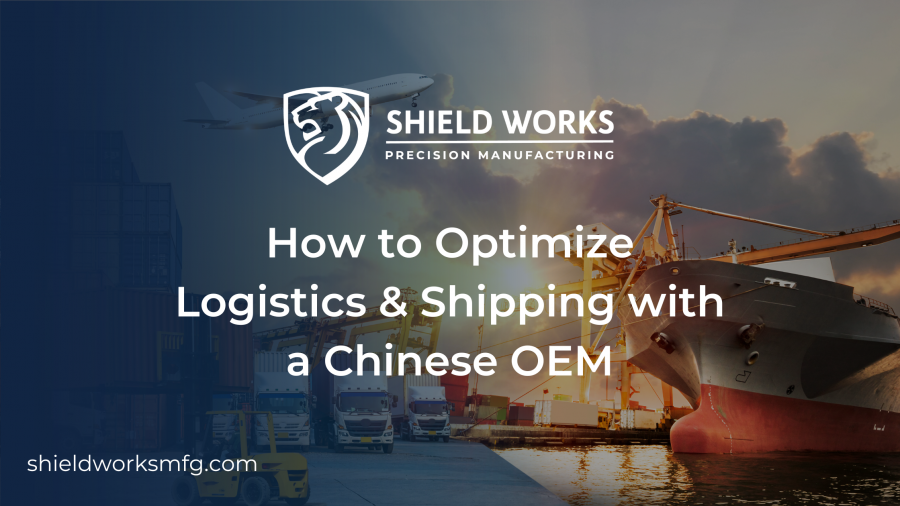
When it comes to running a successful business, logistics and shipping are two crucial factors that can’t be overlooked. Having a reliable supplier that can handle all your shipping needs is essential, especially if you’re sourcing products from China. In this article, we’ll explore how you can optimize your logistics and shipping processes with a Chinese OEM (Original Equipment Manufacturer).
What is an OEM?
Before we dive into the specifics of optimizing logistics and shipping with a Chinese OEM, let’s first define what an OEM is. An OEM is a company that produces parts or products that are used in another company’s final product. For example, a Chinese OEM might produce a component for a smartphone that is then assembled by a different company and sold under their brand.
Why Work with a Chinese OEM?
Working with a Chinese OEM can have many advantages. First and foremost, China is known for its low-cost manufacturing, which means you can often get high-quality products at a lower cost than sourcing domestically. Additionally, many Chinese OEMs are experienced in international shipping and can handle all aspects of the logistics process, including customs clearance and delivery to your doorstep.
Choosing the Right Chinese OEM
Choosing the right Chinese OEM is crucial to the success of your logistics and shipping processes. There are a few key factors you should consider when selecting a supplier:
Experience
Look for a supplier that has experience working with companies in your industry and has a proven track record of delivering high-quality products.
Communication
Communication is essential when working with a supplier in another country. Look for a supplier that is responsive to your emails and willing to communicate via phone or video calls when necessary.
Location
Consider the location of your supplier and how it will impact shipping times and costs. A supplier located near a major port may be able to offer faster and more affordable shipping options.
Optimizing Logistics and Shipping with a Chinese OEM
This involves several crucial steps that can help streamline your operations, reduce shipping costs, and ensure that your shipments arrive on time and in good condition.
Consolidate Shipments
Consolidating your shipments is an effective way to save money on shipping costs. Instead of shipping multiple orders separately, you can combine them into one shipment, taking advantage of economies of scale and negotiating better rates with your freight forwarder. By consolidating your shipments, you can also reduce the number of shipments you receive, which can help you streamline your receiving processes and reduce administrative costs.
Plan Ahead
Planning ahead is essential when it comes to international shipping. Be sure to factor in lead times for manufacturing and shipping when placing orders with your Chinese OEM. Additionally, work with your supplier to create a production and shipping schedule that aligns with your inventory needs. By planning ahead, you can avoid rush fees and ensure that you have enough inventory to meet customer demand.
Use a Reliable Freight Forwarder
Choosing a reliable freight forwarder is critical when shipping from China. A freight forwarder can handle all aspects of the logistics process, including customs clearance, transportation, and delivery to your warehouse or fulfillment center. Look for a freight forwarder that has experience working with Chinese suppliers and can provide you with a range of shipping options, including air and sea freight. A reliable freight forwarder can help you navigate the complexities of international shipping and ensure that your shipments arrive on time and in good condition.
Optimize Packaging
Optimizing your packaging can help you reduce shipping costs and minimize the risk of damage during transit. Work with your Chinese OEM to design packaging that is both lightweight and durable, and that can be stacked efficiently to maximize container space. By optimizing your packaging, you can reduce the volume and weight of your shipments, which can help you save money on shipping costs and reduce your carbon footprint.
Keep Track of Your Inventory
Keeping track of your inventory is critical when working with a Chinese OEM. Make sure you have a system in place to track incoming shipments and inventory levels, and be sure to communicate regularly with your supplier to avoid stockouts or overstocking. By keeping track of your inventory, you can ensure that you have enough stock to meet customer demand and avoid the costs and delays associated with stockouts.
Optimizing logistics and shipping with a Chinese OEM can be a complex process, but by following these tips, you can streamline your operations and save money on shipping costs. Remember to choose a reliable supplier, plan ahead, and work with experienced freight forwarders to ensure your shipments arrive on time and in good condition.
By taking these steps, you can build a strong partnership with your Chinese OEM, one like Shield Works with 18 years of industry experience and both Chinese and international logistics partners, to ensure the success of your business for years to come. Contact us now!
Why Customized Manufacturing is the Best Option for Your Business

Have you ever found yourself grappling with mass-produced products that don’t quite fit the bill of your particular requirements? Have you ever encountered the frustrating circumstance of having to compromise on the design, quality, or functionality of a product simply because it was the only option available on the market? If this is the case, then it’s possible that customized manufacturing is the ideal solution for your business.
In this article, we will delve into the advantages of customized manufacturing and the manner in which it can aid in improving your business operations and augmenting customer satisfaction. From design flexibility to cost savings, we will cover everything that you need to know to make an informed decision regarding customized manufacturing.
Design Flexibility: Unparalleled Advantage
One of the most crucial benefits of customized manufacturing is the unparalleled degree of flexibility that it offers when it comes to design. When you opt to work with a custom manufacturer, you are afforded the freedom to design products that are specifically tailored to meet your particular needs and requirements. You have the liberty to choose materials, dimensions, colors, and finishes that align with your brand and vision.
Moreover, customization allows you to create products that are distinctive and stand out from your competitors. You can integrate innovative features, functionalities, and designs that augment the value of your products and attract more customers. Customization further enables you to customize your products to different markets, demographics, and niches, providing you with a competitive advantage in the market.
Better Quality and Durability: Key Benefits
Another significant advantage of customized manufacturing is the better quality and durability of the products. When you choose to work with a custom manufacturer, you can rest assured that your products are manufactured with top-notch materials and components. You can also oversee the production process to ensure that manufacturing standards and quality control measures are adhered to.
Customized manufacturing also allows you to create products that are robust and long-lasting. You can choose materials that are resistant to wear and tear, corrosion, and environmental factors that affect the product’s lifespan. Furthermore, you can design products that are easy to maintain, repair, and upgrade, thereby reducing the overall cost of ownership and improving customer satisfaction.
Improved Efficiency and Cost Savings: A Winning Combination
Customized manufacturing can also help you improve your business efficiency and reduce costs. When you choose to work with a custom manufacturer, you can optimize the production process to minimize waste, reduce lead times, and improve resource utilization. You can also streamline the supply chain and lower inventory levels by ordering products on-demand.
Moreover, customized manufacturing can help you save costs in the long run. By creating products that cater to your specific needs, you can reduce the costs of purchasing and maintaining multiple products. You can also steer clear of the costs associated with product recalls, returns, and replacements, which can be substantial for mass-produced products that have a high failure rate.
Increased Customer Satisfaction and Loyalty: A Personal Touch
Customized manufacturing can also help you augment customer satisfaction and loyalty. By creating products that cater to your customer’s specific needs and requirements, you can provide a personalized experience that sets you apart from your competitors. You can also ensure that your products meet or exceed your customer’s expectations in terms of quality, design, and functionality.
Furthermore, customized manufacturing allows you to build a relationship with your customers based on trust and transparency. You can involve your customers in the design and production process, obtaining their feedback and suggestions to improve the products. You can also provide after-sales services, such as maintenance, repair, and upgrades, that enhance the overall customer experience and satisfaction.
Improved Brand Image: An Invaluable Asset
When it comes to branding, perception is everything. In today’s marketplace, consumers are becoming increasingly discerning about the products they purchase and the companies they support. Customized manufacturing can be a potent tool in improving your brand image and standing out from the competition. By offering customized products, you demonstrate to your customers that you care about their unique needs and preferences, building trust and loyalty, as well as encouraging positive word-of-mouth marketing.
In addition to this, customization allows you to showcase your company’s creativity and innovation, positioning you as a leader in your industry. Furthermore, customized products can help you stand out in a crowded marketplace. With so many similar products available, customization can be a way to differentiate yourself and offer something truly unique. This can help you attract new customers and retain existing ones, ultimately leading to increased sales and revenue.
Moreover, a strong brand image can help you weather the storms of the market and consumer trends. It can help you maintain customer loyalty and keep your products relevant, even as new players enter the market. By offering customized products, you can create a reputation for quality, innovation, and customer service that will keep your brand strong and valuable for years to come.
Customized manufacturing can offer significant benefits to businesses that are looking to improve their operations and customer satisfaction. From design flexibility to cost savings, customized manufacturing can help you create products that are tailored to your specific needs and requirements, while also improving your brand image and customer loyalty.
By partnering with a reliable and experienced custom manufacturer like Shield Works, with a an international team of engineers and designers as well as in-house assembly where an IPR protective zone is housed, you can ensure that your products are made with high-quality materials and components, meet or exceed your customer’s expectations, and stand out from your competitors in the market. Contact us today!
How to Choose the Right Contract Manufacturer in China
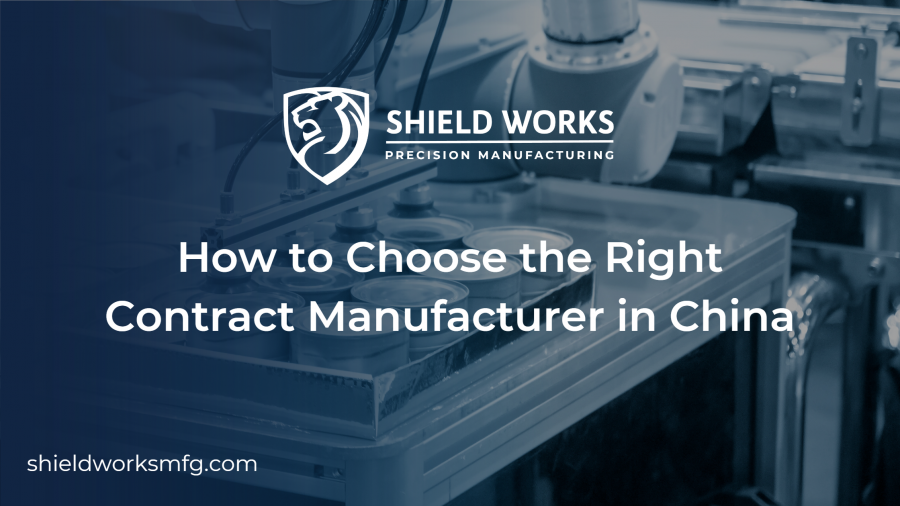
If you’re considering outsourcing your manufacturing operations, China might be an option you’ve already explored. With its vast manufacturing industry, China is a popular destination for companies seeking to manufacture their products at a lower cost. However, with numerous contract manufacturing companies in China, selecting the right one can be challenging.
In this article, we’ll take you through the process of selecting the best contract manufacturing company in China for your needs, keeping in mind the importance of perplexity, burstiness, and low predictability in our writing style.
Step 1: Determine Your Manufacturing Needs
To choose the right contract manufacturing company in China, you must first determine your manufacturing needs. Consider the type of product you want to manufacture, the quantity you require, and your budget. Knowing your needs will help you narrow down your search to companies that specialize in your industry and can meet your production requirements.
Step 2: Research and Shortlist Contract Manufacturing Companies
After determining your manufacturing needs, it’s time to research and shortlist contract manufacturing companies in China. Look for companies that have experience in your industry and offer the services you require. You can use search engines, industry directories, and trade shows to find potential manufacturers. Shortlist at least three to five companies that meet your requirements.
Step 3: Evaluate the Shortlisted Contract Manufacturing Companies
With a shortlist of contract manufacturing companies in China, it’s time to evaluate them. Look for information about their manufacturing capabilities, quality control processes, and certifications. You can also check their website, social media, and online reviews to see what their clients say about their services.
To assess their communication skills, responsiveness, and transparency, it’s a good idea to reach out to the companies and request more information. You can ask for a quote, references, or even arrange a visit to their factory.
Step 4: Compare and Choose the Best Contract Manufacturing Company
After evaluating the shortlisted companies, it’s time to compare and choose the best contract manufacturing company in China for your needs. Consider factors such as their experience, quality, pricing, lead times, and communication skills. Additionally, look for a company with a good reputation that can provide references from satisfied clients.
Before starting any manufacturing project, it’s essential to have a detailed contract in place that outlines all the terms and conditions of the agreement, including payment terms, delivery dates, quality standards, and intellectual property rights.
Step 5: Maintain a Good Relationship with Your Contract Manufacturing Company
Once you’ve chosen a contract manufacturing company in China, it’s crucial to maintain a good relationship with them. Regular communication, timely payments, and feedback can help you build a long-term partnership with your manufacturer. A good relationship can lead to better quality products, faster lead times, and more competitive pricing.
Apart from the above steps, there are a few other things to keep in mind when choosing a contract manufacturing company in China.
Cultural Differences
Firstly, you must consider the cultural differences between China and your home country. It’s essential to understand these differences to avoid any misunderstandings or communication gaps.
Shipping & Logistics
When working with a contract manufacturing company in China, you must consider the cost of shipping and logistics. This includes factoring in the cost of shipping, import duties, and taxes when calculating the total cost of production.
Geopolitics
You must consider the political and economic climate in China as it can significantly impact the manufacturing industry. It’s crucial to keep an eye on any developments that may affect your manufacturing project.
Regulations & Standards
Also ensure that the contract manufacturing company you choose in China is compliant with all the relevant regulations and standards. This includes labor laws, environmental regulations, and quality standards.
As a final note, it’s important to mention that the process of choosing the right contract manufacturing company in China can be time-consuming and requires careful consideration. Rushing into a partnership with a manufacturer without doing proper research and evaluation can lead to costly mistakes and potential production delays.
By following the steps outlined in this article and taking into account the additional considerations mentioned, you can increase your chances of finding a reliable and trustworthy contract manufacturing partner in China. With the right partner, you can achieve your manufacturing goals, maintain quality standards, and remain competitive in your industry.
In conclusion, outsourcing your manufacturing operations to China can be a viable option for companies looking to reduce costs and increase production capacity. However, it’s crucial to choose the right contract manufacturing company that meets your needs, has a good reputation, and is compliant with all relevant regulations and standards, one like Shield Works, with our own precision assembly facility and network of over 500 suppliers, and 18 years of industry experience. Contact us today, and achieve success in your manufacturing projects.
OEM Standards: Why They Matter and What They Are
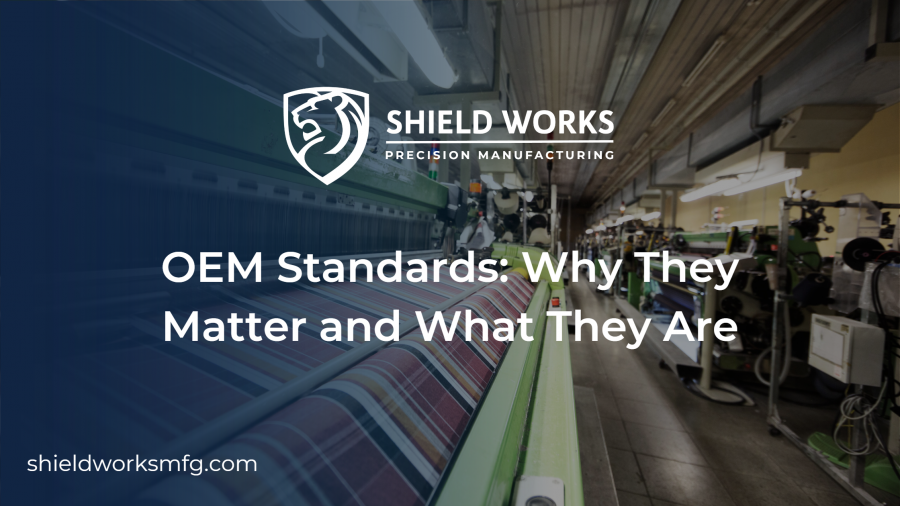
Original Equipment Manufacturer (OEM) standards are the requirements that manufacturers must meet when producing parts or components for a specific product.
These standards are set by the company that originally designed the product, and they outline the quality, safety, and reliability requirements that must be met in order for the parts to be considered acceptable for use in that product.
In this blog post, we will explore why OEM standards are important and how they impact product performance.
Why OEM Standards Matter
OEM standards matter for several reasons, including quality, safety, and reliability.
Quality
First and foremost, OEM standards help to ensure that products are of a consistent quality. By setting specific requirements for materials, manufacturing processes, and testing procedures, manufacturers can minimize variations in product quality and ensure that each component meets the same high standards.
This can help to improve the overall quality of products and increase customer satisfaction.
Safety
In addition, OEM standards are important for ensuring the safety of products. Manufacturers must comply with specific safety regulations and standards to ensure that their products are safe to use.
This may include requirements for components that are flame-retardant, non-toxic, or resistant to high temperatures, among other things. By meeting these safety standards, manufacturers can help to prevent accidents and injuries that may result from product failures or malfunctions.
Reliability
Reliability is another important factor that is impacted by OEM standards. By setting specific requirements for materials, manufacturing processes, and testing procedures, manufacturers can help to ensure that their products are reliable and perform as intended.
This can reduce the risk of product failures or malfunctions that can result in costly repairs or replacements, as well as damage to the manufacturer’s reputation.
In addition to these factors, complying with OEM standards can also have other benefits. For example, it can help manufacturers to streamline their production processes, reduce waste, and improve efficiency. It can also help to encourage innovation and the development of new technologies and methods that can improve product performance and reliability.
How OEM Standards Impact Product Performance
OEM standards play a critical role in determining the performance of a product. There are several ways in which these standards can impact product performance, including materials, manufacturing processes, and testing.
Materials
One of the most important ways in which OEM standards impact product performance is through the use of high-quality materials. This includes:
Material selection
Manufacturers must carefully select the materials used in their products, taking into account factors such as durability, strength, and resistance to wear and tear.
Material quality
The quality of the materials used can impact the performance of the product over time. Using high-quality materials can help to ensure that the product performs well and meets the specific needs of customers.
Manufacturing Process
Manufacturing processes also play a key role in determining product performance. This includes:
Consistency
Manufacturers must ensure that their manufacturing processes are consistent and repeatable in order to minimize variations in product quality and ensure that each component meets the same high standards.
Quality control
Techniques such as statistical process control, automated testing, and continuous improvement programs can help manufacturers improve product performance and reliability, and reduce the risk of defects or malfunctions.
Testing
Testing is another important aspect of OEM standards that impacts product performance. This includes:
Performance testing
Manufacturers must rigorously test each component to ensure that it meets specific performance criteria. This may include tests for strength, durability, resistance to temperature and humidity, and compatibility with other components in the product.
Environmental testing
In some cases, manufacturers may also conduct environmental testing to ensure that their products can withstand harsh conditions, such as extreme temperatures or exposure to saltwater. By conducting these tests, manufacturers can identify and correct potential performance issues before they become a problem for customers.
Design & Innovation
In addition to these factors, OEM standards can also impact product design and innovation. This includes:
Encouraging innovation
By setting specific requirements for materials, manufacturing processes, and testing procedures, manufacturers can encourage the development of new technologies and methods that can improve product performance and reliability.
Creating better products
This can lead to the creation of new products that meet the evolving needs of customers and perform better than previous generations. By staying up to date with OEM standards, manufacturers can create products that are safer, more reliable, and better suited to the needs of their customers.
Overall, OEM standards are important for ensuring the quality, safety, and reliability of products.
By setting specific requirements for materials, manufacturing processes, and testing procedures, manufacturers can improve the overall quality of their products, reduce the risk of accidents or injuries, and protect their reputation in the marketplace.
Whether you are a consumer, manufacturer, or regulator, understanding OEM standards is essential for ensuring the safety and reliability of the products we use every day.
At Shield Works, we understand the importance of OEM standards and the impact they have on product performance. With over 18 years of experience in the industry, we have a professional engineering team that can help you meet the ideal OEM specs and standards for your product. Contact us today to learn more about how we can help you meet your OEM standards and take your product to the next level.
Made in China: Its Pros & Cons
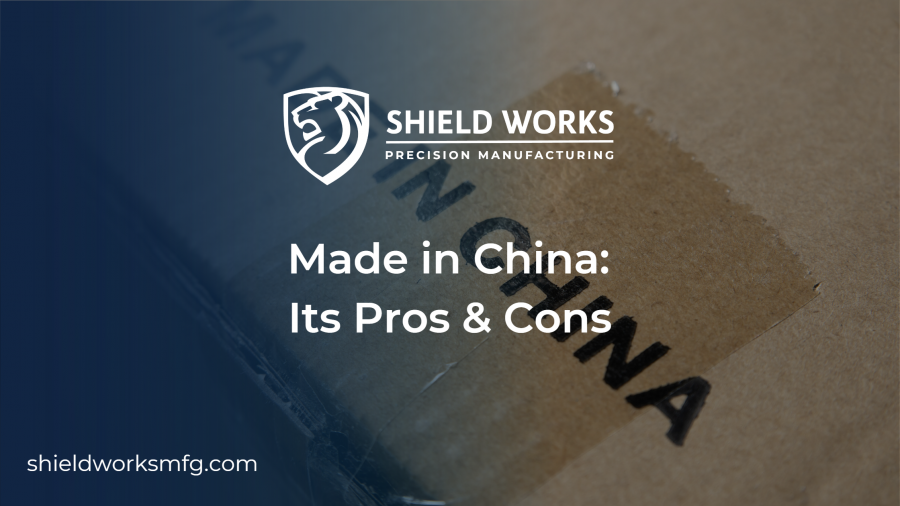
If you have ever purchased a product, it is quite likely that it was made in China. China is the world’s largest exporter and has been manufacturing products for decades. The country’s lower labor costs and large workforce have made it a top destination for businesses looking to pursue higher cost-effectiveness, against all odds.
While there are many benefits to products made in China, there are also drawbacks that you should consider. In this article, we will explore the pros and cons of manufacturing in China.
Pros
Cost Savings
One of the most significant benefits of manufacturing in China is cost savings.
Labor costs in China are lower compared to many other countries, which allows businesses to save on labor costs and invest in other areas of the business such as research and development, marketing, or expanding their product line.
This cost savings can give businesses a competitive edge in the market and allow them to offer products at a lower price point.
Wide Range of Products
China is known for its diverse manufacturing industry that can meet the needs of many businesses. From clothing and electronics to furniture and toys, businesses have access to a wide range of products to sell.
This diversity allows businesses to find suppliers for their specific needs and gives them more options to choose from.
Additionally, Chinese manufacturers have experience in producing large volumes of goods, which can be a significant benefit for businesses looking to scale their operations.
Established Supply Chain
Another benefit of manufacturing in China is the established supply chain.
The country has a well-developed infrastructure that allows for efficient transportation of goods and materials. Additionally, there are many suppliers and manufacturers in China that businesses can work with, making it easier to find the right partner for their needs.
This established supply chain helps businesses reduce costs, increase efficiency, and improve the speed of delivery.
Improved Quality Control
China has made significant improvements in quality control in recent years.
Many manufacturers have invested in new technologies and processes to improve the quality of their products.
This can be a significant benefit for businesses that want to ensure that their products meet high standards. Improved quality control can help businesses reduce costs associated with returns, refunds, and negative customer feedback.
Scalability
Chinese manufacturers have the ability to rapidly scale up production to meet increased demand.
This is due to the country’s large and highly skilled workforce, as well as the advanced technology and equipment that many manufacturers possess.
For businesses looking to expand their product offerings or enter new markets, manufacturing in China can offer the scalability needed to meet growing demand without sacrificing quality or increasing costs.
Additionally, Chinese manufacturers can often provide customized solutions for businesses looking to create new products or modify existing ones to better suit their needs.
Cons
Labor Laws and Working Conditions
China has faced criticism for its labor laws and working conditions in some factories. Reports of long working hours, low wages, and poor working conditions have raised concerns about worker exploitation.
This can be a reputational risk for businesses that partner with manufacturers that have poor labor practices.
Businesses need to conduct proper due diligence to ensure they are working with manufacturers that adhere to local labor laws and have safe working conditions for their employees.
Additionally, businesses can prioritize partnerships with manufacturers that have certifications for ethical labor practices to demonstrate their commitment to social responsibility.
Intellectual Property Theft
Intellectual property theft is a significant concern for businesses that manufacture in China.
There have been many cases of companies having their designs or technology stolen by Chinese manufacturers, which can be a significant threat to a business’s competitiveness.
Businesses need to have proper legal protections in place, such as trademarks and patents, and work with trusted manufacturers to mitigate this risk.
Language and Cultural Barriers
Doing business in China can be challenging due to language and cultural barriers. Many Chinese manufacturers and suppliers do not speak English fluently, which can make communication difficult.
Additionally, there may be cultural differences that can impact business relationships and negotiations. Businesses need to have a clear understanding of cultural differences and have bilingual staff or translators to help bridge the communication gap.
Environmental Concerns
China has been criticized for its environmental practices, with many factories emitting pollutants and contributing to air and water pollution.
This can be a concern for businesses that are committed to environmental sustainability. Businesses need to conduct proper due diligence to ensure they are working with manufacturers that have proper environmental practices in place.
Geopolitical Risks
Finally there are geopolitical risks associated with manufacturing in China. The country’s relationship with the United States and other countries can impact trade policies, tariffs, and regulations.
This can create uncertainty for businesses that rely on stable trade relationships. Additionally, political unrest or changes in the government can create instability in the country, which can impact business operations.
Overall, manufacturing in China is still a very viable option for businesses, but it’s important to weigh the pros and cons carefully and take necessary precautions to mitigate risks. By doing so, businesses can take advantage of the benefits of manufacturing in China while protecting themselves from potential drawbacks.
Or you can consider working with a manufacturer that can help you reap the many benefits of the developed manufacturing in China while perfectly dodging its side-effects. Shield Works is one of them, priding itself on the 18 years of operation, international team of design and development, in-house assembly facility and vast suppler networks in Asia. Contact us now!
Outsourced Assembly: How it Improves Quality
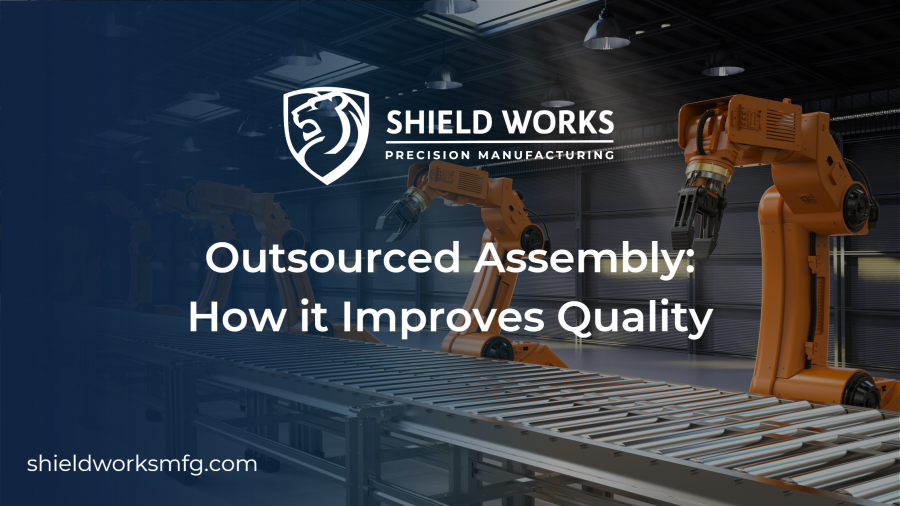
Outsourcing assembly work has become an increasingly popular solution for businesses looking to save costs and time. By delegating assembly work to a trusted third-party partner, companies can focus on their core competencies while reaping a variety of benefits, including cost savings and improved product quality.
In this article, we will explore the ways in which outsourced assembly can help improve quality, increase efficiency, and boost profitability for your business.
Benefits of Outsourced Manufacturing
Reduced Costs
One of the primary benefits of outsourcing assembly work is cost savings. Companies can avoid the costs associated with investing in equipment, machinery, and labor.
Additionally, they can sidestep the expenses associated with employee training, insurance, and benefits. This can result in significant cost savings for businesses of all sizes.
Improved Quality
Outsourcing assembly work to a trusted third-party partner can help improve the quality of your products. These partners specialize in assembly work and have the experience and expertise needed to ensure that your products are manufactured to the highest standards.
They use standardized processes to ensure consistency in the production of your products, minimize errors and defects, and use advanced testing and inspection methods to detect defects and ensure that your products are free from defects.
Increased Efficiency
Outsourcing assembly work can increase efficiency by allowing companies to focus on their core competencies. Employees can spend more time on high-value tasks, such as research and development, marketing, and sales.
This can help businesses to operate more efficiently, streamline their operations, and reduce the time and effort required to produce high-quality products.
Access to Specialized Equipment
Outsourcing assembly work gives companies access to specialized equipment and machinery that they may not have in-house.
This can help businesses to produce high-quality products that meet their customers’ needs. They can also take advantage of the latest technology to improve their assembly processes and increase productivity.
Scalability
Outsourced assembly work can be easily scaled up or down depending on business needs. Companies can adjust the volume of work based on demand without having to worry about hiring and training new employees.
This can help businesses to be more agile and responsive to changing market conditions.
How Outsourced Assembly Improves Quality
Outsourced assembly work can improve the quality of your products in several ways.
Consistency
Outsourced assembly partners follow standardized processes and procedures to ensure consistent quality in the production of your products. This consistency helps to minimize errors and defects, resulting in higher-quality products. By utilizing assembly partners with standardized processes, you can ensure that each product produced meets the same high-quality standards.
Quality Control
Outsourced assembly partners have robust quality control processes in place to ensure that your products meet the highest standards. They use advanced testing and inspection methods to detect defects and ensure that your products are free from defects.
This level of quality control can be difficult to achieve in-house, where resources are often spread thin across many different tasks.
Expertise
Outsourced assembly partners specialize in assembly work and have the expertise and experience needed to produce high-quality products. They can help you identify areas for improvement and make recommendations to optimize your assembly processes.
By leveraging the expertise of these partners, you can improve the quality of your products and identify ways to streamline your assembly process.
Technology
Outsourced assembly partners use advanced technology to improve the quality of your products. They use cutting-edge equipment and software to ensure that your products are manufactured to the highest standards.
By utilizing these technologies, you can ensure that your products are produced with greater accuracy, consistency, and efficiency, resulting in higher-quality products.
Compliance
Outsourced assembly partners are up-to-date on the latest regulations and compliance standards. They can help you ensure that your products meet regulatory requirements and avoid costly fines and penalties.
By working with a partner that is knowledgeable in compliance standards, you can improve the quality of your products and ensure that they are in line with industry regulations.
Outsourcing assembly work can help businesses to reduce costs, improve quality, increase efficiency, and boost profitability. By delegating assembly work to a trusted third-party partner, companies can focus on their core competencies and take advantage of specialized equipment, technology, and expertise.
This can help businesses to be more agile and responsive to changing market conditions and produce high-quality products that meet their customers’ needs.
If you are looking for a product assembler that can help you just that, Shield Works is your perfect option. All your products will be assembled in our in-house facility by a professional team, with our exclusive IP protective zone housed inside. 18 years of experience have well prepared us to bring you a hassle-free and smooth journey to make your dream product. Contact us today!
Custom Manufacturing vs. Mass Production: Which is Right for Your Business?
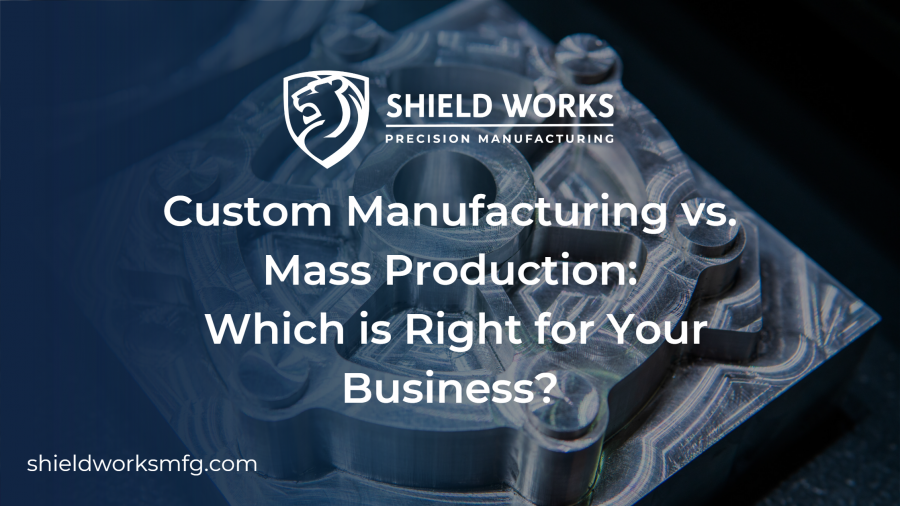
As a business owner, you’re faced with the challenge of choosing between custom manufacturing and mass production when it comes to producing your products.
While both have their advantages and disadvantages, the choice you make can have a significant impact on your business’s success.
In this post, we’ll explore the differences between custom manufacturing and mass production and help you determine which approach is right for your business.
What is Custom Manufacturing?
Custom manufacturing is the process of creating unique products to meet a specific customer’s needs or requirements. The process involves working closely with the customer to design and produce the product.
Custom manufacturing typically involves a more hands-on approach and requires a higher level of skill and expertise.
Benefits of Custom Manufacturing
Customization
Custom manufacturing allows you to create unique products that are tailored to meet the needs of your customers. This level of customization can help you differentiate yourself from your competitors and build a loyal customer base.
Quality
Custom manufacturing typically results in higher quality products as each product is made with specific requirements and standards in mind.
Flexibility
Custom manufacturing allows you to be more flexible in your production process, making changes and adjustments as needed to meet customer demand.
What is Mass Production?
Mass production is the process of creating a large number of identical products using standardized processes and equipment.
The goal of mass production is to produce products quickly and efficiently while minimizing costs.
Benefits of Mass Production
Efficiency
Mass production allows you to produce a large number of products quickly and efficiently. This approach is ideal for businesses that have high demand for their products.
Lower Costs
Mass production can help you reduce your production costs as you can take advantage of economies of scale.
Consistency
Mass production ensures that each product is identical in quality, size, and shape, making it easier to manage inventory and maintain quality control.
What Should Factor into Your Decision-Making?
Product Complexity
One important consideration when deciding between custom manufacturing and mass production is the complexity of the product.
Custom manufacturing is ideal for producing complex, specialized products that require a high level of skill and expertise. This approach allows for greater customization and flexibility, making it easier to produce products that meet specific customer needs.
For example, a custom electronics manufacturer may need to create a unique circuit board design to meet a specific customer’s requirements.
On the other hand, mass production is more suitable for simpler products that can be produced efficiently using standardized processes and equipment.
This approach is ideal for products that have a high demand and can be produced in large volumes. Mass production is commonly used for products such as electronics, clothing, and food items.
Target Market
Another factor to consider is the target market. Custom manufacturing is more suitable for businesses that target a specific niche market or offer specialized products.
This approach allows you to tailor your products to the specific needs and preferences of your target audience.
On the other hand, mass production is better suited for businesses targeting a broader market with a high volume of customers. This approach allows for efficient production and cost savings that can be passed on to the customer in the form of lower prices.
Quality Control
When it comes to quality control, custom manufacturing has the advantage of producing high-quality products that meet specific standards and requirements. Each product is made with individual attention and care, ensuring that the end product is of the highest quality.
On the other hand, mass production can lead to inconsistencies in quality due to the large volume of products produced. However, with proper quality control measures, it is possible to maintain a high level of quality in mass-produced products.
Environmental Impact
Another factor to consider is the environmental impact of each approach. Mass production can result in a large amount of waste due to overproduction, obsolete products, or products that go unsold.
On the other hand, custom manufacturing can be more environmentally friendly as it involves producing products on a smaller scale, reducing waste, and using fewer resources.
Hybrid Approach
A hybrid approach that combines elements of both custom manufacturing and mass production can provide the benefits of both approaches. This approach allows for greater flexibility and customization while still taking advantage of economies of scale.
For example, a company that produces custom clothing may use mass production techniques for the most popular designs and custom manufacturing for specialized or unique items.
By carefully evaluating each approach’s advantages and disadvantages and considering your business’s specific needs, you can make an informed decision that helps your business succeed.
Choosing between custom manufacturing and mass production is a decision that should be carefully considered as it can have a significant impact on your business’s success. By understanding the benefits of each approach and your business’s unique needs and goals, you can make an informed decision that will help you grow and succeed.
With Shield Works, you can have them both. Our in-house facility and professional team of engineers with proven experience will provide you with a streamlined process that combines the perks of both types of manufacturing. Contact us today!
Outsourcing Your Product Assembly Line to China: 7 Tips for Success
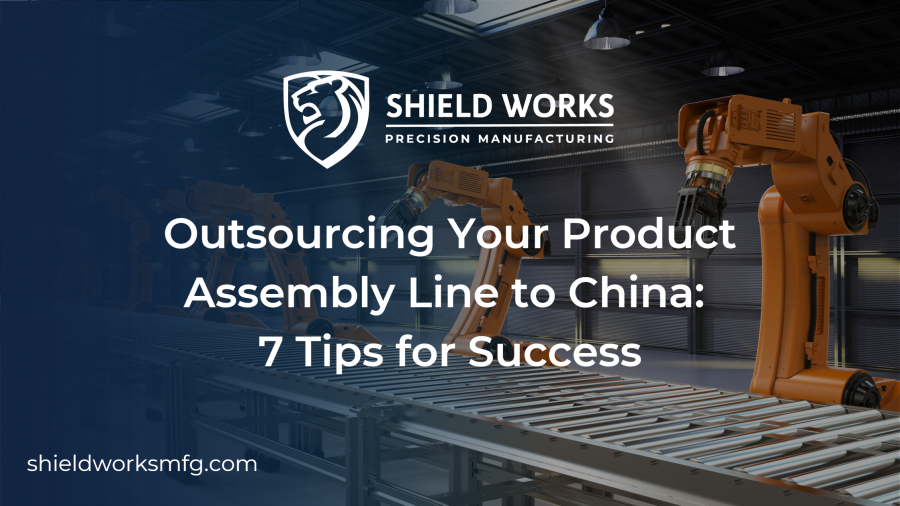
Outsourcing has become increasingly popular among businesses looking to reduce costs and increase efficiency. By outsourcing your product assembly line to China, you can take advantage of lower labor costs and access a highly skilled workforce.
However, outsourcing comes with its own set of challenges, especially when working with international suppliers. Here are seven tips to help you navigate the outsourcing process and achieve success:
Do Your Research
Before outsourcing your product assembly line to China, it’s essential to do your research. This means understanding the specific requirements of your product, including its dimensions, materials, and tolerances. Make sure you have a clear understanding of the manufacturing process and communicate this to your supplier.
When selecting a supplier, you should also consider their experience, reputation, and certifications. Look for a supplier with a proven track record of delivering high-quality products, and consider visiting their facilities to get a firsthand look at their operations.
Find the Right Company
When outsourcing to China, it’s important to find a supplier that can meet your specific needs. This includes lead times, shipping requirements, and final delivery requirements. You should also consider the supplier’s location and proximity to your target market. Working with a local supplier can help reduce shipping costs and lead times.
To find the right supplier, you can attend trade shows, search online directories, or work with a local sourcing agent. Don’t settle for the first offer – bargaining and negotiation are part of international trade, and you may be able to secure a better deal with a little negotiation.
Communicate Effectively
Effective communication is critical to successful outsourcing. Make sure you establish clear lines of communication with your supplier from the outset. This includes setting expectations for communication frequency, communication channels, and language proficiency.
When communicating with your supplier, be clear and detail-oriented. Provide detailed instructions and specifications for your products, including drawings, diagrams, and photographs. You should also be prepared to answer any questions your supplier may have and provide feedback promptly.
Have On-Site Quality Control
For new or complex products, having someone on-site to check quality control is essential. This can be a representative from your company, a third-party inspector, or a quality control specialist provided by your supplier. On-site quality control can help you identify any issues early in the manufacturing process and avoid costly mistakes.
For established and simple products, regular visits may not be necessary. However, you should still stay in touch with your supplier to ensure that the quality of your products remains consistent over time.
Prioritize Price and Quality
When outsourcing your product assembly line to China, it’s important to find a supplier who can balance price and quality. Don’t be tempted to choose a low-cost option that sacrifices quality or communication – this will only lead to higher costs in the long run.
It’s important to have a clear understanding of the costs involved in outsourcing, including shipping and customs fees. Make sure you negotiate favorable payment terms with your supplier to minimize your financial risk.
Set a Timeline
Setting a timeline for product assembly and shipment can help you manage your time better. Consider logistics and delivery when scheduling and be realistic about your expectations. Make sure you discuss timelines with your supplier to ensure that they can meet your deadlines.
When setting a timeline, it’s important to factor in any potential delays or issues that may arise. This will help you avoid unexpected delays and ensure that your products are delivered on time.
Implement Quality Control Systems
Implementing quality control systems at every stage of the manufacturing process is essential. This includes inspecting products at each stage to catch mistakes early and prevent defective products. A manufacturer with experience, like Shield Works, can help ensure quality control.
You should also have a system in place to track and manage any product defects or issues that arise during manufacturing. This can help you identify any recurring issues and work with your supplier to implement corrective actions.
By implementing quality control systems, you can ensure that your products meet your specifications and quality standards, and minimize the risk of costly product recalls or customer complaints.
Outsourcing your product assembly line to China can be a cost-effective solution for your business, but it’s important to be prepared for the challenges that come with it. By doing your research, finding the right supplier, communicating effectively, implementing quality control systems, and prioritizing price and quality, you can achieve successful outsourcing and grow your business.
If you’re considering outsourcing your product assembly line to China, contacting Shield Works can be a smart choice. With their extensive experience in helping western companies outsource their assembly line to China, Shield Works has developed their own in-house assembly facility and IP protection system to ensure the highest standards of quality control and intellectual property protection. Contact Shield Works today to learn how they can help you achieve successful outsourcing and grow your business.
How to Ensure Quality Control in Your Chinese Manufacturing Process

Sourcing products from China has become a popular option for businesses looking to reduce their production costs. However, ensuring the quality of the products can be a challenge due to the variability in manufacturing processes and quality control measures among Chinese suppliers. Product defects can lead to negative consequences for businesses, including loss of customer trust and revenue. In this article, we will discuss some tips to avoid product defects and ensure quality control in your Chinese manufacturing process.
Finding the Right Supplier
The first step in ensuring quality control is finding a reliable supplier. Conducting thorough research is critical to finding a supplier that meets your quality standards. Online directories like Alibaba and Global Sources are great places to start your search. It’s important to research the company information, product information, and reviews from other buyers.
Requesting product samples is also important before committing to a supplier. This will give you a good idea of their product quality and allow you to test them yourself. If possible, visit the supplier in person to inspect their facilities and products. This will give you a better idea of their manufacturing process and quality control measures.
Implementing Quality Control Measures
Once you’ve found a reliable supplier, it’s important to implement quality control measures to ensure that the products you receive meet your quality standards. Here are some tips for implementing quality control measures:
Set Clear Quality Standards
Before production begins, set clear quality standards with your supplier. Make sure they understand your requirements and expectations. Providing clear and detailed quality specifications and reference samples are key to ensuring your supplier understands your requirements.
Conduct Inspections
Conducting inspections throughout the manufacturing process is essential to ensuring your supplier is following your quality standards. This can include pre-production inspections, in-process inspections, and final inspections. It’s critical to ensure that the supplier adheres to the specifications you have provided.
Test the Products
Once the products are finished, test them yourself to ensure that they meet your quality standards. This can include functional tests, safety tests, and durability tests. Make sure to test the products against the specific requirements you have established.
Work with a Third-Party Inspection Company
Consider working with a third-party inspection company to conduct inspections and tests on your behalf. This can provide an objective assessment of your supplier’s quality control measures. Third-party inspection companies are experienced and have the necessary equipment to detect quality issues that you may miss.
Dealing with Product Defects
Even with the best quality control measures in place, product defects can still occur. It’s important to have a plan in place to deal with product defects. Here’s how to deal with product defects:
Identify the Cause of the Defect
Once you’ve identified a defect, work with your supplier to identify the cause. This can help prevent similar defects in the future. If necessary, revise your specifications to prevent similar issues in the future.
Take Action to Prevent Future Defects
Once you’ve identified the cause of the defect, take action to prevent similar defects in the future. This can include updating your quality control measures or finding a new supplier. It’s important to take proactive steps to prevent future issues.
Additional Tips of Maintaining Supplier Relationship
On top of technical aspects, maintaining a good relationship with your suppliers is also important. Here are some additional tips.
Communicate Clearly
Communication is key when working with Chinese suppliers. Make sure that you are communicating your requirements and expectations clearly and regularly. Use simple language and avoid jargon or technical terms that may be difficult to translate.
Build a Relationship
Building a relationship with your supplier can help to ensure that they prioritize your needs and requirements. This can be done by visiting their facilities, attending trade shows, and maintaining regular communication.
Be Flexible
Chinese suppliers may have different ways of doing things, and it’s important to be flexible and open to new ideas. Consider working with your supplier to find a compromise that meets your needs and their capabilities.
Manage your Supply Chain
Managing your supply chain effectively can help to prevent quality issues. This includes managing your inventory, ensuring timely deliveries, and working with your supplier to resolve any issues that arise.
Stay Up-to-Date
Stay up-to-date on the latest industry trends and regulations. This can help you to identify potential quality issues before they arise and ensure that your products are compliant with relevant regulations.
By following these tips, you can help to ensure that the products you receive from China meet your quality standards and are free from defects. Remember, quality control is an ongoing process that requires regular communication, collaboration, and monitoring.
To avoid negative consequences, businesses sourcing products from China must prioritize quality control. The key steps include finding a reliable supplier, implementing quality control measures, dealing with product defects, and maintaining a good relationship with the supplier. Remember that quality control is an ongoing process that requires regular communication, collaboration, and monitoring.
If you work with an experienced third-party quality control company, it’ll be much easier. One like Shield Works, with 18 years of QC experience and a professional QC team based throughout China and Southeast Asia. Contact us now!
